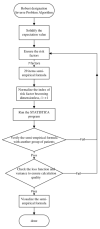Quantitative Prediction of SYNTAX Score for Cardiovascular Artery Disease Patients via the Inverse Problem Algorithm Technique as Artificial Intelligence Assessment in Diagnostics
- PMID: 36553187
- PMCID: PMC9777487
- DOI: 10.3390/diagnostics12123180
Quantitative Prediction of SYNTAX Score for Cardiovascular Artery Disease Patients via the Inverse Problem Algorithm Technique as Artificial Intelligence Assessment in Diagnostics
Abstract
The quantitative prediction of the SYNTAX score for cardiovascular artery disease patients using the inverse problem algorithm (IPA) technique in artificial intelligence was explored in this study. A 29-term semi-empirical formula was defined according to seven risk factors: (1) age, (2) mean arterial pressure, (3) body surface area, (4) pre-prandial blood glucose, (5) low-density-lipoprotein cholesterol, (6) Troponin I, and (7) C-reactive protein. Then, the formula was computed via the STATISTICA 7.0 program to obtain a compromised solution for a 405-patient dataset with a specific loss function [actual-predicted]2 as low as 3.177, whereas 0.0 implies a 100% match between the prediction and observation via "the lower, the better" principle. The IPA technique first created a data matrix [405 × 29] from the included patients' data and then attempted to derive a compromised solution of the column matrix of 29-term coefficients [29 × 1]. The correlation coefficient, r2, of the regression line for the actual versus predicted SYNTAX score was 0.8958, showing a high coincidence among the dataset. The follow-up verification based on another 105 patients' data from the same group also had a high correlation coefficient of r2 = 0.8304. Nevertheless, the verified group's low derived average AT (agreement) (ATavg = 0.308 ± 0.193) also revealed a slight deviation between the theoretical prediction from the STATISTICA 7.0 program and the grades assigned by clinical cardiologists or interventionists. The predicted SYNTAX scores were compared with earlier reported findings based on a single-factor statistical analysis or scanned images obtained by sonography or cardiac catheterization. Cardiologists can obtain the SYNTAX score from the semi-empirical formula for an instant referral before performing a cardiac examination.
Keywords: SYNTAX; artificial intelligence; cardiovascular artery disease; computational analysis; inverse problem algorithm.
Conflict of interest statement
The authors declare no conflict of interest.
Figures







References
-
- Kastrati A., Schömig A., Elezi S., Dirschinger J., Mehilli J., Schühlen H., Blasini R., Neumann F.-J. Prognostic Value of the Modified American College of Cardiology/American Heart Association Stenosis Morphology Classification for Long-Term Angiographic and Clinical Outcome After Coronary Stent Placement. Circulation. 1999;100:1285–1290. doi: 10.1161/01.CIR.100.12.1285. - DOI - PubMed
-
- Ghebreyesus T.A. Monitoring Health for the Sustainable Development Goals. World Health Organization; Geneva, Switzerland: 2020. Electronic Version.
-
- Chen S.Z. Population Health and Welfare Quality Indicators Report 2017. 1st ed. Ministry of Health and Welfare; Taiwan, China: 2019.
-
- Akboga M.K., Balci K.G., Maden O., Ertem A.G., Kirbas O., Yayla C., Acar B., Aras D., Kisacik H., Aydogdu S. Usefulness of monocyte to HDL-cholesterol ratio to predict high SYNTAX score in patients with stable coronary artery disease. Biomark. Med. 2016;10:375–383. doi: 10.2217/bmm-2015-0050. - DOI - PubMed
LinkOut - more resources
Full Text Sources
Research Materials

